科技运用在教育的利弊(英文论文)
在课堂上使用科技的优缺点英语作文
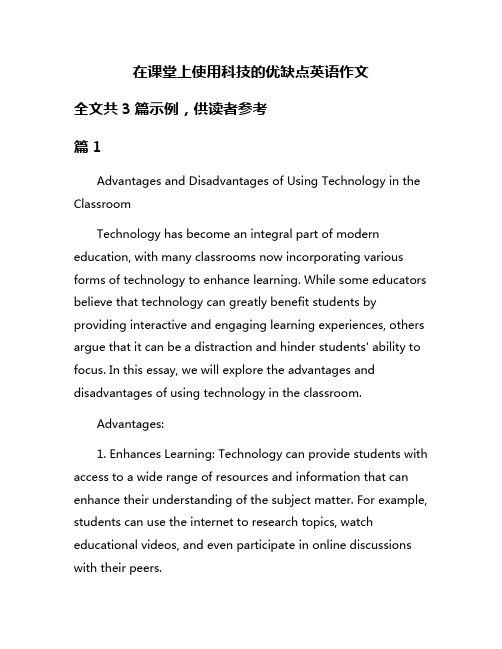
在课堂上使用科技的优缺点英语作文全文共3篇示例,供读者参考篇1Advantages and Disadvantages of Using Technology in the ClassroomTechnology has become an integral part of modern education, with many classrooms now incorporating various forms of technology to enhance learning. While some educators believe that technology can greatly benefit students by providing interactive and engaging learning experiences, others argue that it can be a distraction and hinder students' ability to focus. In this essay, we will explore the advantages and disadvantages of using technology in the classroom.Advantages:1. Enhances Learning: Technology can provide students with access to a wide range of resources and information that can enhance their understanding of the subject matter. For example, students can use the internet to research topics, watch educational videos, and even participate in online discussions with their peers.2. Increases Engagement: Technology can make learning more interactive and fun for students. For example, teachers can use interactive whiteboards and educational games to keep students engaged and motivated to learn. This can help students retain information better and improve their academic performance.3. Customized Learning: Technology can be used to create personalized learning experiences for students based on their individual needs and learning styles. For example, teachers can use online assessments to identify students' strengths and weaknesses and provide them with targeted resources to help them improve.4. Collaboration: Technology can facilitate collaboration among students and between students and teachers. For example, students can use online platforms to work on group projects, share resources, and communicate with their teachers outside of class.Disadvantages:1. Distraction: One of the biggest drawbacks of using technology in the classroom is the potential for distraction. With access to smartphones, tablets, and other devices, students maybe tempted to check social media, play games, or browse the internet instead of focusing on the lesson.2. Technology Dependence: Relying too heavily on technology in the classroom can hinder students' ability to think critically and solve problems on their own. Students may become too reliant on technology to provide them with answers and may struggle to develop important skills such as research and writing.3. Inequality: Not all students have equal access to technology outside of the classroom, which can create a digital divide and disadvantage some students. For example, students from lower-income families may not have access to a computer or the internet at home, making it difficult for them to complete homework assignments or participate in online discussions.4. Security and Privacy Concerns: Using technology in the classroom can raise concerns about security and privacy. For example, schools may need to implement strict policies to protect students' personal information and ensure that their online activities are safe and secure.In conclusion, while technology can provide many benefits in the classroom, it is important for educators to be mindful of its potential drawbacks and implement strategies to minimize them. By striking a balance between technology and traditionalteaching methods, educators can ensure that students receive the best possible learning experience.篇2Advantages and Disadvantages of Using Technology in the ClassroomTechnology has become an integral part of our daily lives, and its presence in the classroom is becoming more prevalent. In this essay, I will discuss the advantages and disadvantages of using technology in the classroom.Advantages:1. Enhances learning experience: Technology in the classroom can provide students with interactive and engaging ways to learn. For example, using educational apps or online resources can make learning more fun and accessible for students.2. Improves student engagement: Technology can help students stay engaged and focused during lessons. Interactive whiteboards, educational games, and multimedia presentations can capture students' attention and make learning more enjoyable.3. Encourages collaboration: Technology can facilitate collaboration among students. For instance, students can work together on projects using online tools, share ideas through discussion forums, and collaborate on documents in real-time.4. Customizes learning: Technology allows teachers to cater to the individual learning needs of students. With personalized learning software, teachers can create customized lessons and assessments to help students achieve their full potential.5. Prepares students for the future: By using technology in the classroom, students are exposed to tools and skills that are essential in the digital age. This can better prepare them for their future careers and help them adapt to the rapidly changing technological landscape.Disadvantages:1. Distraction: One of the main disadvantages of technology in the classroom is that it can be a distraction for students. With access to smartphones, tablets, and laptops, students may be tempted to use these devices for non-educational purposes during class.2. Unequal access: Not all students have equal access to technology outside of the classroom. This can create disparitiesin learning experiences and outcomes, as students with limited access to technology may be at a disadvantage compared to their peers.3. Technology glitches: Using technology in the classroom can sometimes lead to technical issues, such as software glitches or internet connectivity problems. These disruptions can disrupt the flow of the lesson and hinder students' learning experience.4. Dependence on technology: Relying too heavily on technology in the classroom can lead to a dependence on these tools. Students may struggle to learn without technology, and teachers may find it challenging to teach without these resources.5. Privacy concerns: Using technology in the classroom raises privacy concerns, as student data may be collected and shared without their knowledge or consent. Teachers and schools must take steps to protect students' privacy and secure their data.In conclusion, while technology in the classroom offers many advantages, it also comes with its fair share of disadvantages. It is essential for educators to strike a balance and use technology in a way that enhances learning without overshadowing traditional teaching methods. Ultimately, technology should be seen as a tool to support and supplement classroom instruction,rather than a replacement for human interaction and engagement.篇3Advantages and Disadvantages of Using Technology in the ClassroomTechnology has become an integral part of our everyday lives, and its presence in the classroom is steadily increasing. While there are many benefits to using technology in the classroom, there are also some drawbacks that must be considered. In this essay, we will explore the advantages and disadvantages of using technology in the classroom.One of the biggest advantages of using technology in the classroom is the ability to engage students in new and exciting ways. Technology can make learning more interactive and engaging, which can help students stay focused and interested in the material. For example, using multimedia presentations and interactive simulations can help students better understand complex concepts and make learning more enjoyable.Another benefit of using technology in the classroom is the ability to personalize learning experiences for students. Technology makes it easier for teachers to cater to the individualneeds of each student and provide them with resources that are tailored to their learning style. For example, teachers can use online quizzes and assessments to track students' progress and identify areas where they may need extra help.Additionally, technology can help students develop important 21st-century skills such as critical thinking and problem-solving. By using technology, students can engage in collaborative projects, conduct research, and analyze data in ways that were not possible before. This can help them develop the skills they need to succeed in an increasingly digital world.However, using technology in the classroom also has some drawbacks. One of the main concerns is that technology can be a distraction for students. With the internet and social media at their fingertips, students may be tempted to surf the web or check their phones during class, which can detract from their learning experience.Another disadvantage of using technology in the classroom is the potential for technical issues to arise. If the technology fails to work properly or if there are internet connectivity problems, it can disrupt the flow of the lesson and create frustration for both teachers and students. This can be particularly problematic inschools that have limited resources and may not have the necessary technical support.Furthermore, some critics argue that technology can lead to a decrease in face-to-face interaction and communication skills. In a technology-driven classroom, students may spend less time interacting with their peers and teachers in person, which can hinder their social development and ability to communicate effectively.In conclusion, the use of technology in the classroom has both advantages and disadvantages. While technology can enhance learning experiences, engage students, and help them develop important skills, it can also be a distraction, lead to technical issues, and hinder face-to-face communication. It is important for educators to carefully consider these pros and cons and find a balance that allows them to leverage the benefits of technology while minimizing its drawbacks. Ultimately, technology should be used as a tool to enhance learning and support student success in the classroom.。
科技在教育中的利弊英语作文
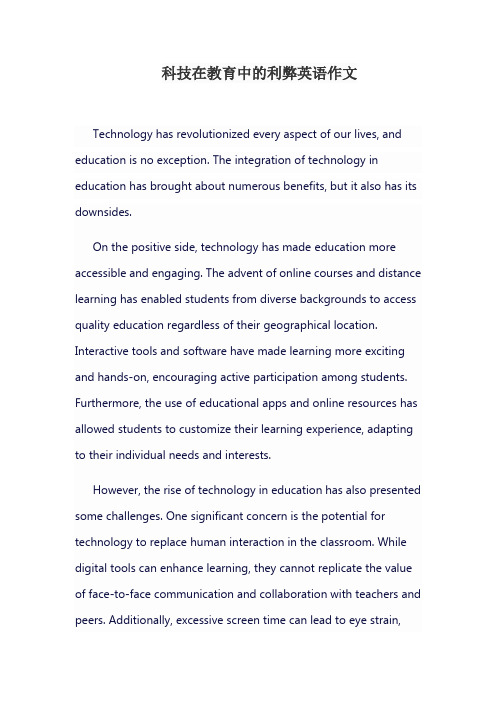
科技在教育中的利弊英语作文Technology has revolutionized every aspect of our lives, and education is no exception. The integration of technology in education has brought about numerous benefits, but it also has its downsides.On the positive side, technology has made education more accessible and engaging. The advent of online courses and distance learning has enabled students from diverse backgrounds to access quality education regardless of their geographical location. Interactive tools and software have made learning more exciting and hands-on, encouraging active participation among students. Furthermore, the use of educational apps and online resources has allowed students to customize their learning experience, adapting to their individual needs and interests.However, the rise of technology in education has also presented some challenges. One significant concern is the potential for technology to replace human interaction in the classroom. While digital tools can enhance learning, they cannot replicate the value of face-to-face communication and collaboration with teachers and peers. Additionally, excessive screen time can lead to eye strain,posture problems, and even decreased attention spans among students. Moreover, the reliance on technology can create digital divides, with students from disadvantaged backgrounds lacking access to the necessary tools and resources.In conclusion, while technology has brought remarkable advancements to education, it is crucial to strike a balance. Educators should utilize technology as a tool to enhance learning rather than replacing traditional teaching methods. Additionally, efforts should be made to ensure that all students have equal access to technology and its benefits, minimizing the negative impacts of the digital divide.。
科技对学生的利与弊英语作文
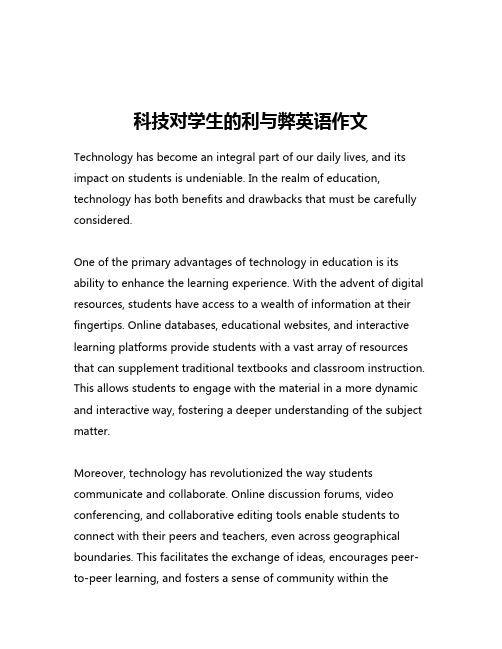
科技对学生的利与弊英语作文Technology has become an integral part of our daily lives, and its impact on students is undeniable. In the realm of education, technology has both benefits and drawbacks that must be carefully considered.One of the primary advantages of technology in education is its ability to enhance the learning experience. With the advent of digital resources, students have access to a wealth of information at their fingertips. Online databases, educational websites, and interactive learning platforms provide students with a vast array of resources that can supplement traditional textbooks and classroom instruction. This allows students to engage with the material in a more dynamic and interactive way, fostering a deeper understanding of the subject matter.Moreover, technology has revolutionized the way students communicate and collaborate. Online discussion forums, video conferencing, and collaborative editing tools enable students to connect with their peers and teachers, even across geographical boundaries. This facilitates the exchange of ideas, encourages peer-to-peer learning, and fosters a sense of community within theeducational environment.Another significant benefit of technology in education is its potential to cater to diverse learning styles. Students have varying preferences and abilities when it comes to absorbing information. Some may thrive in a visual learning environment, while others may excel in a more auditory or kinesthetic approach. Technology offers a range of tools and resources that can accommodate these different learning styles, enabling students to engage with the material in a way that best suits their individual needs.Furthermore, technology has the ability to provide personalized learning experiences. Adaptive learning software and algorithms can analyze a student's performance and adjust the content and pace of instruction accordingly. This personalized approach can help address individual strengths, weaknesses, and learning pace, ultimately leading to more efficient and effective learning outcomes.However, the integration of technology in education is not without its drawbacks. One of the primary concerns is the potential for technology to be a distraction. With the abundance of digital devices and online entertainment options, students may find it challenging to maintain focus and discipline during learning activities. The temptation to engage in non-academic activities, such as social media or gaming, can undermine the intended educational goals.Another drawback of technology in education is the potential for inequity and accessibility issues. Not all students have equal access to technology, either due to socioeconomic factors or geographical limitations. This digital divide can create a gap in educational opportunities, further exacerbating existing disparities in the education system.Additionally, the reliance on technology in education can raise concerns about data privacy and security. The collection and storage of student data, including personal information and academic performance, raise ethical and legal questions about data protection and the potential misuse of such information.Moreover, the rapid pace of technological change can create challenges for educators in keeping up with the latest tools and resources. Continuous professional development and training are necessary to ensure that teachers are equipped to effectively integrate technology into their teaching practices and provide students with the necessary digital skills.In conclusion, the impact of technology on students is a complex and multifaceted issue. While technology offers numerous benefits, such as enhanced learning experiences, improved communication and collaboration, and personalized instruction, it also presentssignificant challenges, including the potential for distraction, issues of equity and accessibility, and concerns about data privacy and security. As educators and policymakers navigate this ever-evolving landscape, it is crucial to strike a balance between the advantages and drawbacks of technology in education, ensuring that its implementation serves the best interests of students and promotes equitable and effective learning outcomes.。
科技运用在教育的利弊(英文论文)

科技运用在教育的利弊(英文论文)With the rapid advancement of technology, it is undeniable that it has greatly influenced the field of education. In recent years, the integration of technology into classrooms has become a common occurrence, revolutionizing the way students learn and teachers teach.Firstly, technology has made learning more interactive and engaging. Gone are the days of traditional chalk and talk methods. Nowadays, students have access to a vast array of educational resources, such as online textbooks, interactive learning platforms, and educational apps. These tools enable students to explore concepts in a more personalized and interactive manner, enhancing their understanding and retention of knowledge.Secondly, technology has expanded the boundaries of education beyond the classroom walls. Through the internet, students can now access educational materials and resources from all over the world. They can participate in online courses, communicate with experts in various fields, and collaborate with students from different countries. This globalconnectivity broadens their horizons and fosters a deeper understanding of different cultures and perspectives.However, it is worth noting that technology should be used as a tool, not a substitute for effective teaching. While technology can enhance the learning experience, it cannot replace the guidance and expertise of a qualified teacher. Therefore, it is crucial for educators to strike a balance between traditional teaching methods and the integration of technology.In conclusion, technology has undoubtedly reshaped the landscape of education. Its impact can be seen in the way students learn and teachers teach. By embracing technology and utilizing it effectively, we can harness its potential to create a more engaging and inclusive learning environment for students.。
科技对教育的影响英语作文_The Impact of Science and Technology

科技对教育的影响英语作文_The Impact of Science and Technology on Education 5关于”科技对教育的影响“的英语作文范文5篇,作文题目:The Impact of Science and Technology on Education。
以下是关于科技对教育的影响的高一英语范文,每篇作文均为真题范文带翻译。
关于”科技对教育的影响“的英语作文范文5篇,作文题目:The Impact of Science and Technology on Education。
以下是关于科技对教育的影响的高一英语范文,每篇作文均为真题范文带翻译。
高分英语作文1:The Impact of Science and Technology on Education We may be surprised by the progress in every field of research, but it's extraordinary that the way to test a person's knowledge and ability is still as primitive as before. After all these years, educators still haven't designed a more effective and reliable method than the test, because they sincerely claim that the test tests what you know, which is common sense It may be a good way to test your memory or a knack for working quickly under extreme pressure. However, as a maker of anxiety, examinations can't tell you one's real abilities and talents. Examinations are second to none because they depend on examinations to a great extent. Examinations are a sign of success or failure in our society The future may be decided on a decisive day. From the moment a child starts to go to school, he enters a world of fiercecompetition.There are clear definitions and measures for success and failure. Can we be surprised at the increasing number of dropouts, young people who are considered to be total losers before they start working. Can we be surprised at the rate of students? A good education should, etc., train yourself to think about the examination system and do nothing, but what must be learned is strictly regulated by the syllabus.Therefore, encouraging students to recall examinations can not motivate students to read widely, but restrict their reading, which can not make them seek more knowledge, but induce cramming The most successful job seekers are not always the best educated. They are the best trained in the skills of working under pressure.中文翻译:我们也许会对每一个研究领域的进步感到惊讶,但是测试一个人的知识和能力的方法仍然像以前一样原始,真是太不寻常了,经过这么多年,教育家们仍然没有设计出比考试更有效、更可靠的方法,因为他们虔诚地宣称考试测试的是你所知道的东西,这是一个常识,即考试往往会适得其反,这可能是测试记忆力的好方法,或是在极端压力下快速工作的诀窍,但作为焦虑的制造者,考试并不能告诉你一个人真正的能力和才能,考试是首屈一指的,这是因为在很大程度上取决于考试,考试是我们社会成功或失败的标志,你的整个未来可能在一个决定性的日子里决定,从孩子开始上学的那一刻起,他进入了一个竞争激烈的世界,成功和失败都有明确的定义和衡量标准。
在课堂上使用科技的优缺点英语作文

The Advantages and Disadvantages of Using Technology in ClassroomsIn today's era of rapid technological advancement, the integration of technology into classrooms has become increasingly prevalent. This trend has revolutionized traditional teaching methods, bringing about numerous benefits but also posing some challenges. This essay aimsto explore the advantages and disadvantages of using technology in classrooms.Firstly, let's delve into the advantages ofincorporating technology into classrooms. One significant benefit is the enhancement of student engagement. Through interactive tools like smartboards and digital applications, students can actively participate in lessons, makinglearning more enjoyable and effective. Technology also provides access to vast amounts of information, enabling students to delve deeper into subjects and broaden their knowledge horizons. Additionally, it allows teachers to customize learning experiences, catering to individual student needs and learning styles.Moreover, technology can facilitate collaboration and communication among students. With the help of online platforms, students can work together on projects, share ideas, and discuss concepts, fostering a collaborative learning environment. This collaborative approach not only enhances learning outcomes but also cultivates important skills such as teamwork and critical thinking.However, despite these advantages, there are also some disadvantages associated with using technology in classrooms. One major concern is the potential for technology to become a distraction. With smartphones, tablets, and other devices constantly at their fingertips, students may be tempted to stray from their studies and engage in non-academic activities. This can lead to adecline in attention and focus, affecting learning outcomes. Furthermore, the reliance on technology can sometimes lead to a decrease in traditional skills. For instance, excessive use of digital tools may result in students becoming less proficient in handwriting or calculating mentally. Additionally, technology-based assessments maynot fully capture students' understanding and problem-solving abilities, as they often rely on multiple-choice or fill-in-the-blank formats.Moreover, the integration of technology into classrooms requires significant financial investment. Not all schools have the resources to purchase and maintain expensive technological equipment, creating a digital divide between schools with access to technology and those without. This divide can exacerbate educational disparities and limit access to quality education for some students.In conclusion, the use of technology in classrooms offers numerous benefits, including enhanced student engagement, access to vast information, customized learning experiences, and collaboration opportunities. However, it also poses challenges such as potential distractions, a decline in traditional skills, limitations in assessment methods, and financial constraints. It is, therefore, crucial for teachers and educators to strike a balance and ensure that technology is used effectively andappropriately to enhance the learning process rather than becoming a hindrance.**课堂上使用科技的优缺点**在当今科技飞速发展的时代,科技在课堂上的融合变得日益普遍。
科技教育的优缺点,英语作文素材
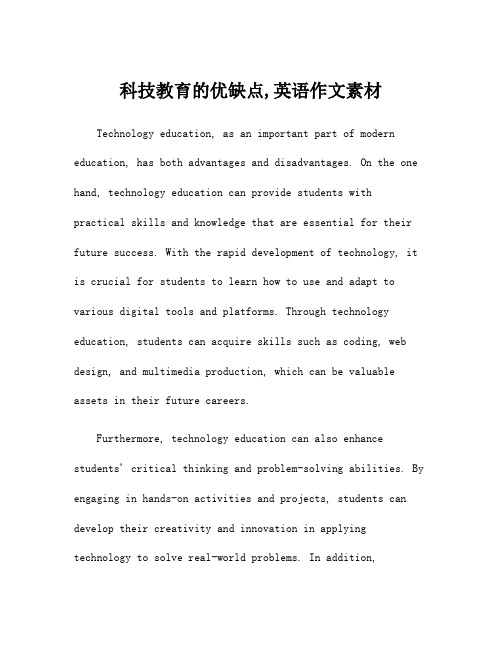
科技教育的优缺点,英语作文素材Technology education, as an important part of modern education, has both advantages and disadvantages. On the one hand, technology education can provide students withpractical skills and knowledge that are essential for their future success. With the rapid development of technology, it is crucial for students to learn how to use and adapt to various digital tools and platforms. Through technology education, students can acquire skills such as coding, web design, and multimedia production, which can be valuable assets in their future careers.Furthermore, technology education can also enhance students' critical thinking and problem-solving abilities. By engaging in hands-on activities and projects, students can develop their creativity and innovation in applying technology to solve real-world problems. In addition,technology education can also promote collaboration and communication skills, as students often need to work in teams to complete complex tasks.On the other hand, technology education may also have some drawbacks. One of the main concerns is that excessive reliance on technology may lead to a lack of traditional skills and knowledge. As students focus more on digital literacy, they may neglect essential subjects such as mathematics, science, and humanities. This imbalance could result in gaps in students' overall education and hindertheir holistic development.Moreover, the rapid pace of technological advancement poses a challenge for educators to keep up with the latest trends and updates. Technology education requires continuous learning and adaptation, and not all teachers may have the necessary expertise or resources to effectively integrate technology into their teaching practices. This could lead touneven quality of technology education across different schools and regions.In conclusion, technology education offers various benefits in terms of practical skills, critical thinking, and collaboration. However, it also raises concerns about neglecting traditional education and the challenges of keeping up with rapid technological changes. It is crucialfor educators to strike a balance and ensure that technology education complements, rather than replaces, traditional learning methods.。
科技给教育带来的影响英语作文
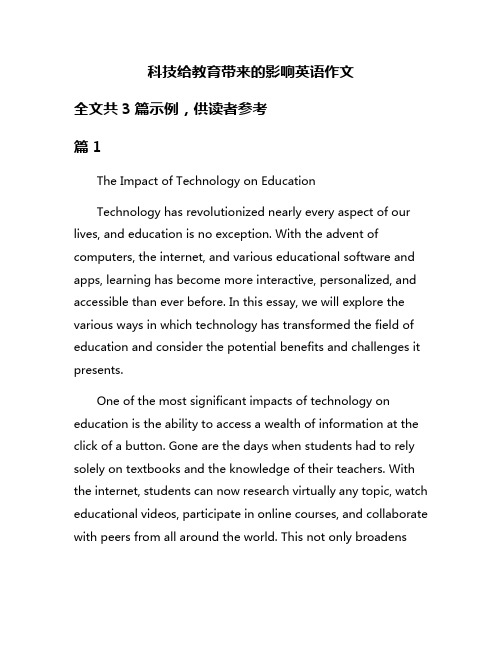
科技给教育带来的影响英语作文全文共3篇示例,供读者参考篇1The Impact of Technology on EducationTechnology has revolutionized nearly every aspect of our lives, and education is no exception. With the advent of computers, the internet, and various educational software and apps, learning has become more interactive, personalized, and accessible than ever before. In this essay, we will explore the various ways in which technology has transformed the field of education and consider the potential benefits and challenges it presents.One of the most significant impacts of technology on education is the ability to access a wealth of information at the click of a button. Gone are the days when students had to rely solely on textbooks and the knowledge of their teachers. With the internet, students can now research virtually any topic, watch educational videos, participate in online courses, and collaborate with peers from all around the world. This not only broadenstheir knowledge base but also fosters critical thinking, problem-solving skills, and a love of learning.Furthermore, technology has made education more personalized and flexible. Online learning platforms and adaptive software can tailor lessons to each student's individual learning style, pace, and interests. This allows students to learn at their own pace, revisit material as needed, and engage with the content in a way that suits them best. Additionally, technology enables educators to track student progress more effectively and provide targeted support and feedback.Another benefit of technology in education is the enhancement of communication and collaboration. With tools like video conferencing, chat rooms, and online forums, students can easily connect with their peers and teachers, regardless of physical distance. This promotes collaboration, creativity, and a sense of community among learners. Furthermore, technology allows students to work on group projects, share resources, and receive feedback in real-time, all of which are essential skills for success in the modern workplace.However, despite its numerous benefits, technology in education also poses some challenges. One of the key concerns is the digital divide, where students from low-incomebackgrounds or rural areas may not have access to the same technology and resources as their more affluent peers. This can widen existing achievement gaps and perpetuate inequalities in education. Additionally, there is a risk of students becoming overly reliant on technology and neglecting essential skills such as critical thinking, creativity, and face-to-face communication.In conclusion, technology has undeniably transformed the field of education in profound ways. It has made learning more interactive, personalized, and accessible, and has opened up new opportunities for collaboration and communication. However, it is essential to address the challenges posed by technology in education, such as the digital divide and the potential loss of essential skills. By doing so, we can harness the full potential of technology to empower learners, improve educational outcomes, and prepare students for success in a rapidly changing world.篇2The Impact of Technology on EducationIntroductionIn recent years, technological advancements have transformed nearly every aspect of our lives, including education. The integration of technology in classrooms has revolutionizedthe way students learn, teachers educate, and educational institutions operate. In this essay, we will explore the impact of technology on education and discuss how it has reshaped the learning process.Enhanced Learning ExperienceOne of the most significant benefits of technology in education is the enhanced learning experience for students. With the internet, students have access to a vast amount of information at their fingertips. They can conduct research, watch educational videos, and participate in online discussions to deepen their understanding of various subjects. Additionally, interactive learning tools and software enable students to engage with the material in a more dynamic and immersive way, making learning more enjoyable and effective.Improved Teacher EffectivenessTechnology has also transformed the role of teachers in the classroom. Teachers can now use digital tools to create engaging lesson plans, track student progress, and provide personalized feedback to students. With online resources and platforms, teachers can easily create and share educational content, collaborate with other educators, and stay up-to-date on the latest teaching techniques. This not only improves teachereffectiveness but also allows for more individualized instruction tailored to each student's needs.Increased AccessibilityTechnology has made education more accessible to students of all backgrounds and abilities. With online learning platforms, students can access educational resources from anywhere in the world, making education more flexible and convenient. Additionally, technology has made it easier for students with disabilities to access learning materials and participate in classroom activities. Tools such as screen readers, speech recognition software, and adaptive devices have leveled the playing field for students with diverse learning needs.Challenges of Technology in EducationWhile technology has brought many benefits to education, it also presents challenges that must be addressed. One of the most pressing issues is the digital divide, which refers to the gap between those who have access to technology and those who do not. Inequities in access to devices and internet connectivity can hinder students' ability to fully participate in online learning and access educational resources. Additionally, the rapid pace of technological change can be overwhelming for teachers whomay not have the necessary training and support to effectively integrate technology into their teaching practices.ConclusionIn conclusion, technology has had a profound impact on education, revolutionizing the way students learn and teachers educate. By enhancing the learning experience, improving teacher effectiveness, and increasing accessibility, technology has the potential to transform education for the better. However, as we continue to innovate and integrate technology in education, it is essential to address the challenges and ensure that all students have equal opportunities to benefit from these advancements. Only then can we truly harness the power of technology to create a more inclusive and effective educational system.篇3The Impact of Technology on EducationIntroductionIn today's fast-paced and digital age, technology has significantly transformed various aspects of our lives, including education. With the integration of technology into classrooms, educators and students are now experiencing new opportunitiesand challenges that were previously unimaginable. The impact of technology on education is vast and profound, and its benefits are evident in the modern educational landscape. In this essay, we will explore the positive and negative effects of technology on education and how it has revolutionized the way we teach and learn.Positive Impacts of Technology on Education1. Access to Information and ResourcesOne of the most significant benefits of technology in education is the easy access to information and resources. With the internet and digital tools, students can now access a vast repository of knowledge, research materials, and educational resources from anywhere in the world. This has democratized education and made learning more accessible to students of all backgrounds and abilities.2. Interactive Learning ExperiencesTechnology has also transformed the traditional classroom into a more interactive and engaging learning environment. Through digital tools such as educational games, simulations, and multimedia resources, educators can create dynamic and interactive lessons that cater to different learning styles andabilities. This hands-on approach to learning helps students better understand and retain information.3. Personalized LearningTechnology has enabled personalized learning, where educators can tailor instruction to meet the specific needs and learning styles of individual students. With the use of educational software and adaptive learning platforms, students can progress at their own pace and receive targeted support and feedback based on their performance. This individualized approach to learning fosters student engagement and academic success.4. Collaboration and CommunicationTechnology has made collaboration and communication among students and educators more efficient and effective. Through online platforms, students can work together on group projects, share ideas and feedback, and collaborate with peers from around the world. This fosters a sense of community and encourages teamwork and social skills development.5. Enhanced Teacher Professional DevelopmentTechnology has also revolutionized teacher professional development, providing educators with access to online courses, webinars, and resources to improve their teaching skills and staycurrent with the latest educational trends and best practices. This continuous professional development benefits both educators and students by ensuring that teachers are well-equipped to deliver high-quality instruction.Negative Impacts of Technology on Education1. Digital DistractionsOne of the most significant challenges of technology in education is the potential for digital distractions to disrupt learning. With the proliferation of smartphones, tablets, and other digital devices, students may be tempted to use these devices for non-academic purposes during class time, leading to a loss of focus and productivity. Educators must find ways to mitigate these distractions and promote responsible use of technology in the classroom.2. Technological InequitiesDespite the benefits of technology in education, there is a growing concern about technological inequities among students. Not all students have equal access to digital tools and resources, which can widen the achievement gap and hinder their academic success. Educators and policymakers must work to ensure that allstudents have access to technology and the skills to navigate the digital world effectively.3. Privacy and Security ConcernsAnother downside of technology in education is the potential for privacy and security breaches. As schools collect and store vast amounts of student data, there is a risk of this information being compromised or misused. Educators must take steps to protect student privacy and ensure the security of digital platforms and tools used in the classroom.4. Overreliance on TechnologyWhile technology has revolutionized education, there is a risk of overreliance on digital tools and platforms at the expense of traditional teaching methods. Educators must strike a balance between technology and traditional pedagogy to ensure that students receive a well-rounded and holistic education that fosters critical thinking, creativity, and problem-solving skills.ConclusionIn conclusion, technology has had a profound impact on education, ushering in a new era of learning that is personalized, interactive, and collaborative. While the benefits of technology in education are numerous, there are also challenges thateducators must address to maximize its potential and ensure that all students benefit from the opportunities that technology offers. By embracing technology in the classroom and fostering responsible and effective use of digital tools, educators can harness the power of technology to enhance teaching and learning and prepare students for success in the digital age.。
科技如何在教育上利大于弊英语作文
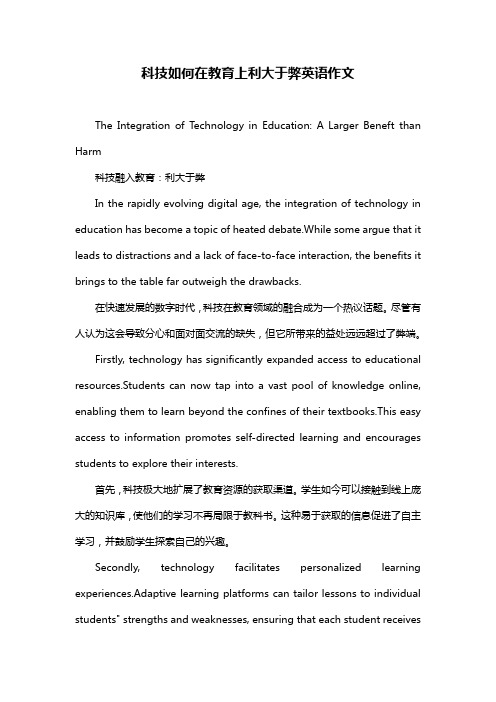
科技如何在教育上利大于弊英语作文The Integration of T echnology in Education: A Larger Beneft than Harm科技融入教育:利大于弊In the rapidly evolving digital age, the integration of technology in education has become a topic of heated debate.While some argue that it leads to distractions and a lack of face-to-face interaction, the benefits it brings to the table far outweigh the drawbacks.在快速发展的数字时代,科技在教育领域的融合成为一个热议话题。
尽管有人认为这会导致分心和面对面交流的缺失,但它所带来的益处远远超过了弊端。
Firstly, technology has significantly expanded access to educational resources.Students can now tap into a vast pool of knowledge online, enabling them to learn beyond the confines of their textbooks.This easy access to information promotes self-directed learning and encourages students to explore their interests.首先,科技极大地扩展了教育资源的获取渠道。
学生如今可以接触到线上庞大的知识库,使他们的学习不再局限于教科书。
这种易于获取的信息促进了自主学习,并鼓励学生探索自己的兴趣。
高科技教学的利与弊英语作文
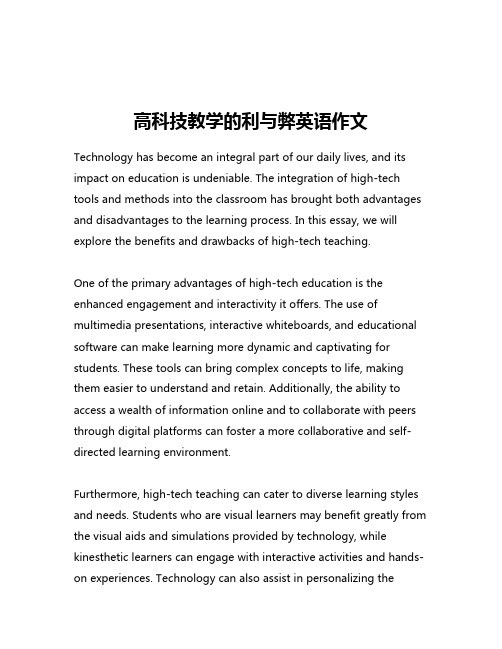
高科技教学的利与弊英语作文Technology has become an integral part of our daily lives, and its impact on education is undeniable. The integration of high-tech tools and methods into the classroom has brought both advantages and disadvantages to the learning process. In this essay, we will explore the benefits and drawbacks of high-tech teaching.One of the primary advantages of high-tech education is the enhanced engagement and interactivity it offers. The use of multimedia presentations, interactive whiteboards, and educational software can make learning more dynamic and captivating for students. These tools can bring complex concepts to life, making them easier to understand and retain. Additionally, the ability to access a wealth of information online and to collaborate with peers through digital platforms can foster a more collaborative and self-directed learning environment.Furthermore, high-tech teaching can cater to diverse learning styles and needs. Students who are visual learners may benefit greatly from the visual aids and simulations provided by technology, while kinesthetic learners can engage with interactive activities and hands-on experiences. Technology can also assist in personalizing thelearning experience, allowing teachers to tailor content and pacing to the individual needs of their students.Another significant advantage of high-tech teaching is the potential for increased efficiency and productivity. Digital tools can streamline administrative tasks, such as grading and record-keeping, allowing teachers to devote more time to lesson planning and one-on-one interactions with students. Additionally, the availability of online resources and educational software can reduce the need for physical textbooks and other traditional materials, leading to cost savings for both schools and families.However, the integration of high-tech teaching also comes with its own set of challenges. One of the primary concerns is the potential for technological failures or malfunctions, which can disrupt the learning process and cause frustration for both teachers and students. Reliable and consistent access to technology, as well as adequate technical support, is crucial for the successful implementation of high-tech teaching methods.Another drawback of high-tech education is the risk of increased distractions and reduced focus. With the abundance of digital devices and online resources available, students may be tempted to engage in activities unrelated to the lesson, such as browsing social media or playing games. This can lead to a lack of attention and adecrease in overall academic performance.Furthermore, the reliance on technology can also raise concerns about equity and accessibility. Not all students may have equal access to high-tech devices and reliable internet connectivity, which can create a digital divide and disadvantage those from lower-income backgrounds or underserved communities. This disparity can exacerbate existing educational inequalities and hinder the goal of providing equal learning opportunities for all students.Additionally, the overuse of technology in the classroom can lead to a decrease in face-to-face interaction and social skills development. While digital communication and collaboration are important, there is a risk of students becoming overly reliant on technology and neglecting the essential interpersonal skills needed for successful academic and social integration.In conclusion, the integration of high-tech teaching methods in the classroom has both advantages and disadvantages. While the enhanced engagement, personalization, and efficiency offered by technology can greatly benefit the learning process, it is crucial to address the challenges posed by technological failures, distractions, equity concerns, and the potential loss of face-to-face interaction. Ultimately, a balanced and thoughtful approach to the use oftechnology in education is necessary to ensure that high-tech teaching truly enhances the learning experience for all students.。
科技教育的优缺点,英语作文素材
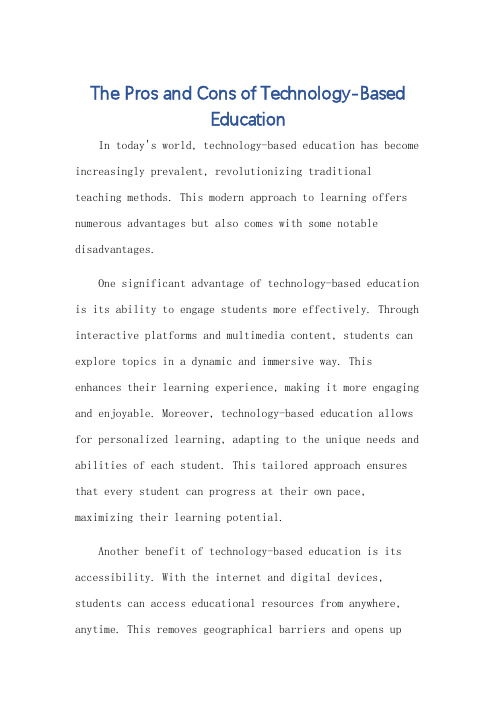
The Pros and Cons of Technology-BasedEducationIn today's world, technology-based education has become increasingly prevalent, revolutionizing traditional teaching methods. This modern approach to learning offers numerous advantages but also comes with some notable disadvantages.One significant advantage of technology-based education is its ability to engage students more effectively. Through interactive platforms and multimedia content, students can explore topics in a dynamic and immersive way. This enhances their learning experience, making it more engaging and enjoyable. Moreover, technology-based education allows for personalized learning, adapting to the unique needs and abilities of each student. This tailored approach ensures that every student can progress at their own pace, maximizing their learning potential.Another benefit of technology-based education is its accessibility. With the internet and digital devices, students can access educational resources from anywhere, anytime. This removes geographical barriers and opens upeducational opportunities to a wider range of students, regardless of their location. Furthermore, online courses and virtual classrooms provide flexibility, allowing students to fit their learning into their busy schedules. However, despite these advantages, technology-based education also has its downsides. One significant concernis the potential for technology to become a distraction. With the constant availability of digital devices and the internet, students may find it difficult to focus on their studies. They may be tempted to check social media, play games, or engage in other non-academic activities instead of devoting their attention to learning.Moreover, technology-based education can sometimes lack the human touch and interaction that traditional classrooms provide. In a digital environment, students may miss out on the benefits of face-to-face communication andcollaboration with their peers and teachers. This canaffect their social skills and ability to work in teams, which are crucial for success in today's world.Additionally, while technology-based education offers a vast array of resources, it can also be overwhelming forstudents. With so much information available, it can be difficult to filter out what is relevant and important. This can lead to information overload and make it harderfor students to focus on the core content of their courses. In conclusion, technology-based education offers numerous benefits but also comes with some challenges. It enhances engagement, provides accessibility, and offers personalized learning experiences. However, it also poses risks of distraction, lacks human interaction, and can be overwhelming with information. Therefore, it is essential to strike a balance when incorporating technology into the educational process, ensuring that it complementstraditional teaching methods rather than replacing them.**科技教育的优缺点**在当今世界,科技教育日益盛行,正在逐步改变传统的教学方法。
高科技对教学利弊英语作文

高科技对教学利弊英语作文The Impact of High-Tech on Education: Pros and ConsIn recent years, the integration of high-tech into education has been a topic of hot debate. The use of technology in the classroom has both positive and negative effects on teaching and learning. This essay aims to explore the advantages and disadvantages of incorporating high-tech in education.Pros:1. Enhanced Engagement: High-tech tools, such as interactive whiteboards, tablets, and educational apps, can significantly increase student engagement. These tools make learning more interactive, fun, and immersive, thus capturing students' attention and motivating them to learn.2. Personalized Learning: Technology allows for personalized learning experiences. Adaptive learning platforms and intelligent tutoring systems can cater to individual students' needs, providing customized content, pace, and support. This individualized approach can help students learn more effectively.3. Access to a Wealth of Information: The internet and digital resources provide students and teachers with access to an vast amount of information. This enables more comprehensive research, a broader range of perspectives, and up-to-date content, enhancing the quality ofeducation.4. Collaboration and Communication: Technology facilitates collaboration and communication among students and teachers. Online discussion forums, video conferencing, and collaborative projects enable students to work together, share ideas, and learn from one another, regardless of geographical constraints.5. Improved Teacher Efficiency: High-tech tools can streamline administrative tasks, grading, and lesson planning, allowing teachers to focus more on instruction and student support. This increased efficiency can lead to better teaching outcomes.Cons:1. Technology Disruptions: Technical issues, such as hardware malfunctions, software bugs, and connectivity problems, can disrupt the learning process. These disruptions can waste valuable class time and frustrate both students and teachers.2. Access Inequality: Not all students have equal access to technology. Economic disparities can create a digital divide, where students from low-income families may be at a disadvantage, lacking the necessary devices or internet access to fully participate in tech-driven education.3. Distractions: The use of technology in the classroom can be a double-edged sword. While it can enhance engagement, it can also be a source of distraction. Students might use devices for non-educationalpurposes, such as playing games or browsing social media, leading to decreased focus and productivity.4. Overreliance on T echnology: There is a risk that students may become overly dependent on technology, potentially hindering their ability to perform basic tasks without digital assistance. Moreover, an overreliance on technology may undermine the development of critical thinking and problem-solving skills.5. Privacy Concerns: The use of technology in education raises privacy issues. Student data collected through educational platforms and apps may be vulnerable to breaches, raising concerns about the security and confidentiality of personal information.In conclusion, the integration of high-tech in education offers numerous benefits, including increased engagement, personalized learning, and improved teacher efficiency. However, it also presents challenges such as technology disruptions, access inequality, distractions, overreliance, and privacy concerns. To maximize the advantages and mitigate the disadvantages, a balanced approach is necessary, ensuring that technology is used appropriately and equitably to enhance teaching and learning.。
科技在教育中的利弊英语作文

科技在教育中的利弊英语作文Technology has undoubtedly transformed the way education is delivered and received. On one hand, it has brought about significant benefits, such as increased access to educational resources and enhanced interactive learning experiences for students. On the other hand, it also poses certain drawbacks, such as potential distraction and overreliance on technology. Therefore, it is essentialto critically examine the advantages and disadvantages of technology in education.科技无疑已经改变了教育的传递和接收方式。
一方面,它带来了巨大的好处,比如增加了对教育资源的获取,并且为学生提供了更丰富的互动学习体验。
另一方面,它也存在一定的缺点,比如潜在的分散注意力和对科技的过度依赖。
因此,有必要对教育中科技的利弊进行批判性的审视。
From a positive perspective, the integration of technology in education has greatly expanded access to educational resources. For example, students now have access to an abundance of online educational materials, including e-books, articles, videos, and interactive simulations. This effectively breaks down the barriers oftraditional brick-and-mortar classrooms and provides students with a wealth of learning materials at their fingertips.从积极的角度来看,科技在教育中的整合大大扩展了对教育资源的获取。
高中英语作文《探讨科技对教育的影响》
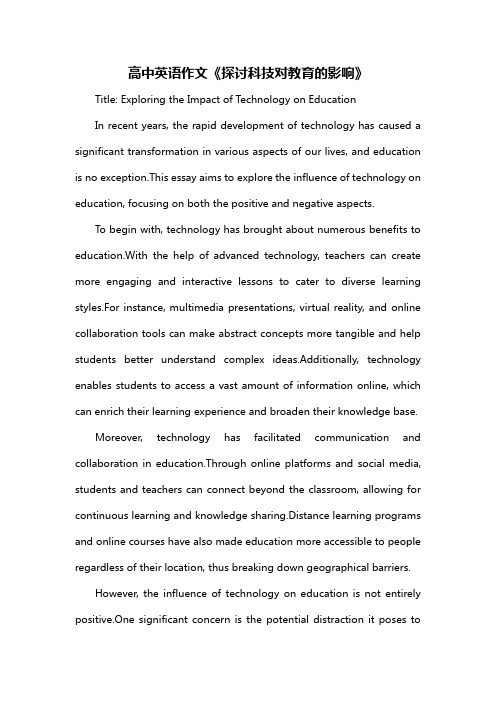
高中英语作文《探讨科技对教育的影响》Title: Exploring the Impact of Technology on EducationIn recent years, the rapid development of technology has caused a significant transformation in various aspects of our lives, and education is no exception.This essay aims to explore the influence of technology on education, focusing on both the positive and negative aspects.To begin with, technology has brought about numerous benefits to education.With the help of advanced technology, teachers can create more engaging and interactive lessons to cater to diverse learning styles.For instance, multimedia presentations, virtual reality, and online collaboration tools can make abstract concepts more tangible and help students better understand complex ideas.Additionally, technology enables students to access a vast amount of information online, which can enrich their learning experience and broaden their knowledge base.Moreover, technology has facilitated communication and collaboration in education.Through online platforms and social media, students and teachers can connect beyond the classroom, allowing for continuous learning and knowledge sharing.Distance learning programs and online courses have also made education more accessible to people regardless of their location, thus breaking down geographical barriers.However, the influence of technology on education is not entirely positive.One significant concern is the potential distraction it poses tostudents.With numerous entertainment options and social media platforms at their fingertips, students may find it difficult to stay focused on their studies.Moreover, excessive reliance on technology may lead to a lack of critical thinking and problem-solving skills, as students become accustomed to finding answers with a simple click.Another concern is the digital divide that exists within society.Not all students have equal access to technology and the internet, which can create disparities in educational opportunities.This gap can further widen existing social inequalities, making it challenging for some students to compete on a level playing field.In conclusion, technology has undoubtedly had a significant impact on education, bringing both opportunities and challenges.To harness its potential, it is crucial for educators and policymakers to strike a balance between utilizing technology to enhance learning experiences and ensuring that students develop essential skills such as critical thinking and problem-solving.Additionally, efforts should be made to provide equal access to technology to bridge the digital divide and create a more inclusive educational environment for all.。
高科技教学的利弊英文作文
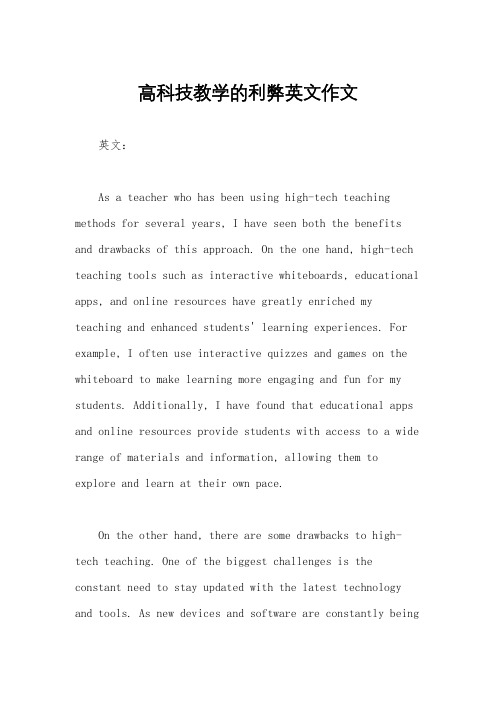
高科技教学的利弊英文作文英文:As a teacher who has been using high-tech teaching methods for several years, I have seen both the benefits and drawbacks of this approach. On the one hand, high-tech teaching tools such as interactive whiteboards, educational apps, and online resources have greatly enriched my teaching and enhanced students' learning experiences. For example, I often use interactive quizzes and games on the whiteboard to make learning more engaging and fun for my students. Additionally, I have found that educational apps and online resources provide students with access to a wide range of materials and information, allowing them to explore and learn at their own pace.On the other hand, there are some drawbacks to high-tech teaching. One of the biggest challenges is the constant need to stay updated with the latest technology and tools. As new devices and software are constantly beingdeveloped, it can be overwhelming to keep up with the changes. Moreover, some students may become overly reliant on technology and struggle with traditional learning methods. For example, I have noticed that some studentshave difficulty focusing on a traditional lecture after being accustomed to interactive and multimedia-rich lessons.中文:作为一名使用高科技教学方法多年的教师,我见证了这种方法的利与弊。
科技对学生的利与弊英语作文
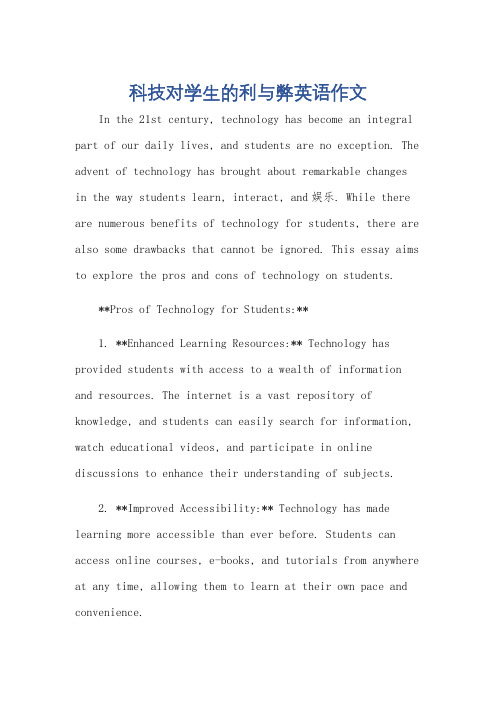
科技对学生的利与弊英语作文In the 21st century, technology has become an integral part of our daily lives, and students are no exception. The advent of technology has brought about remarkable changesin the way students learn, interact, and娱乐. While there are numerous benefits of technology for students, there are also some drawbacks that cannot be ignored. This essay aims to explore the pros and cons of technology on students.**Pros of Technology for Students:**1. **Enhanced Learning Resources:** Technology has provided students with access to a wealth of information and resources. The internet is a vast repository of knowledge, and students can easily search for information, watch educational videos, and participate in online discussions to enhance their understanding of subjects.2. **Improved Accessibility:** Technology has made learning more accessible than ever before. Students can access online courses, e-books, and tutorials from anywhere at any time, allowing them to learn at their own pace and convenience.3. **Collaborative Learning:** Technology hasfacilitated collaborative learning among students. Online platforms such as forums, wikis, and social media allow students to work together, share ideas, and learn from each other, promoting a sense of community and cooperation.4. **Enhanced Creativity:** Technology has provided students with tools to express their creativity. Digital art, animation, video editing, and other digital media allow students to create and share their works with a wider audience, fostering creativity and innovation.5. **Improved Communication Skills:** Technology has enhanced students' communication skills. Email, social media, and video conferencing allow students to communicate with their peers and teachers effectively, improving their ability to express themselves and understand others.**Cons of Technology for Students:**1. **Addiction to Screens:** The constant use of screens for learning and entertainment can lead to addiction and dependency on technology. Excessive screen time can affect students' physical health, causing eye strain, neck pain, and other health issues.2. **Distraction and Lack of Focus:** Technology can bea major distraction for students, leading to a lack of focus and attention. Social media, video games, and other digital distractions can pull students' attention away from their studies, affecting their academic performance.3. **Privacy and Security Concerns:** The use of technology can raise privacy and security concerns for students. Sharing personal information and photos online can put students at risk of cyberbullying, identity theft, and other cybercrimes.4. **Isolation and Social Isolation:** While technology can connect students with a wide range of people, it can also lead to isolation and social isolation.过度使用数字设备可能会导致学生减少与他人的面对面交流,影响他们的社交技能和情感发展。
信息技术给教育带来的利弊英语作文120字
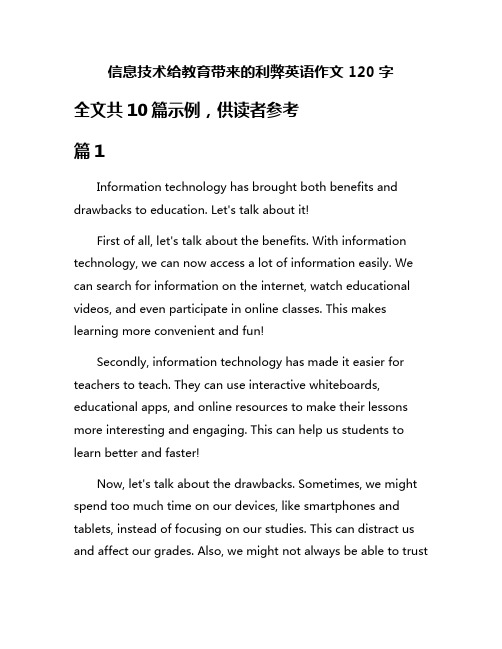
信息技术给教育带来的利弊英语作文120字全文共10篇示例,供读者参考篇1Information technology has brought both benefits and drawbacks to education. Let's talk about it!First of all, let's talk about the benefits. With information technology, we can now access a lot of information easily. We can search for information on the internet, watch educational videos, and even participate in online classes. This makes learning more convenient and fun!Secondly, information technology has made it easier for teachers to teach. They can use interactive whiteboards, educational apps, and online resources to make their lessons more interesting and engaging. This can help us students to learn better and faster!Now, let's talk about the drawbacks. Sometimes, we might spend too much time on our devices, like smartphones and tablets, instead of focusing on our studies. This can distract us and affect our grades. Also, we might not always be able to trustthe information we find online, so we need to be careful and check multiple sources.In conclusion, information technology has definitely changed the way we learn and teach. It has made learning more convenient and interactive, but we need to be careful not to rely too much on it. Let's use technology wisely and enjoy the benefits it brings to education!篇2Information technology has brought both advantages and disadvantages to education. Let's talk about it!First of all, let's talk about the benefits of information technology in education. With computers, tablets, and the internet, we can learn new things more easily. We can search for information quickly and find answers to our questions in no time. We can also watch educational videos and play games that help us learn in a fun way. Information technology has made learning more interactive and engaging for all of us.But, there are also some drawbacks to using information technology in education. For example, some students may become too dependent on technology and lose their ability to think critically. They may rely too much on the internet forinformation and not develop their own research skills. Also, spending too much time in front of screens can be bad for our eyes and our health. We need to make sure we balance our use of technology with other activities like reading books and playing outside.In conclusion, information technology has changed the way we learn in many ways. It has made learning more accessible and fun, but we also need to be careful not to rely too much on it. We should use technology wisely and make sure we are still developing our critical thinking skills. So, let's embrace the benefits of information technology in education while being mindful of its drawbacks. Let's keep learning and growing with the help of technology!篇3Information technology has brought both advantages and disadvantages to education. Let's talk about it in a simple and easy way!First of all, let's talk about the advantages. Information technology makes learning more interesting and fun. We can use computers, tablets, and smartphones to watch educationalvideos, play interactive games, and do online quizzes. It helps us to understand difficult concepts and remember things better.Secondly, information technology helps us to access a lot of information easily. We can search for information on the internet, read e-books, and watch online classes. It helps us to learn new things and explore different topics. We can also communicate with teachers and classmates through messaging apps and video calls.On the other hand, there are also disadvantages of using information technology in education. Sometimes, we may spend too much time on devices and become addicted to them. It can affect our eyesight, sleep, and social skills. We may also get distracted by social media and games, and forget to focus on our studies.Moreover, not everyone has access to information technology. In some schools and countries, students may not have access to computers or the internet. This creates a digital divide and prevents some students from getting the same opportunities for learning.In conclusion, information technology has its pros and cons in education. It's important to use it wisely and balance our screen time. Let's embrace the benefits of technology whilebeing mindful of its drawbacks. Let's make the most of technology to learn and grow, but also remember to take breaks, go outside, and connect with people face to face. Let's make education fun, exciting, and meaningful with the help of information technology!篇4Okay! Let me write a fun and friendly essay on the advantages and disadvantages of information technology in education.Hey guys! Today, we're gonna talk about how cool information technology is and how it's helping us learn and grow in school. But, it's not all sunshine and rainbows, there are some downsides too. So, let's dive in and explore the world of technology in education!First off, let's talk about the good stuff. Information technology has made learning so much more fun and interesting. We can watch educational videos, play interactive games, and even take virtual field trips without leaving the classroom. How awesome is that? It helps us understand difficult concepts better and makes studying more engaging.Another great thing about technology in education is that it makes learning more accessible. We can access information from anywhere, anytime with just a click of a button. No more lugging around heavy textbooks or spending hours in the library. Everything we need is right at our fingertips, making studying a breeze.But, as with everything, there are some drawbacks too. One of the biggest concerns is that technology can be distracting. With our smartphones and tablets at our disposal, it's easy to get sidetracked by social media, games, and cat videos (trust me, I've been there). This can lead to a decrease in focus and productivity, which isn't good for our grades.Another downside is that not everyone has access to the latest technology. Some schools may not have the resources to provide students with laptops or tablets, which puts those students at a disadvantage. This creates a digital divide between those who have access to technology and those who don't, which isn't fair.In conclusion, information technology has brought a lot of benefits to education, but it also comes with its challenges. We need to find a balance between using technology as a tool to enhance learning and being mindful of its potential drawbacks.As long as we use technology responsibly and in moderation, we can make the most out of it and take our education to the next level!篇5Information technology has brought both advantages and disadvantages to education. Let's talk about it!First of all, information technology has made learning more fun and interesting. We can use computers, tablets, and the internet to access a lot of information and resources. We can watch educational videos, play interactive games, and communicate with teachers and classmates online. It makes learning so easy and convenient!Secondly, information technology helps us to improve our studying efficiency. We can use software and apps to organize our schedules, take notes, and do research. We can also use online tools for language learning, math practice, and science experiments. It helps us to learn faster and better!On the other hand, there are some disadvantages of using information technology in education. Sometimes, we may become too reliant on technology and forget about traditional learning methods. We may also get distracted by social media,games, and other entertainment when using devices for studying. It's important to balance our screen time and focus on learning.In conclusion, information technology has definitely brought a lot of benefits to education, but we should also be aware of its drawbacks and use it wisely. Let's embrace the technology while staying disciplined and focused on our studies. Happy learning!篇6Information technology has brought both advantages and disadvantages to education. Let me tell you all about it!First, let's talk about the advantages. With information technology, we can now access a ton of information online. We can learn about different things just by searching on the internet. We can also use educational apps and websites to help us study better. For example, we can use online calculators to solve math problems or language learning apps to improve our English skills. It's super cool!Another advantage is that information technology has made learning more fun and interactive. We can watch educational videos, play educational games, and even take virtual field trips to different places around the world. It makes learning more exciting and interesting. Plus, we can communicate with teachersand classmates through online platforms, which makes it easier to ask questions and collaborate on projects.But, of course, there are also some disadvantages. One of them is that sometimes we rely too much on technology for learning. We might forget how to do things without a computer or a smartphone. We might also get distracted easily by other things on the internet, like social media or video games, which can affect our studying.Additionally, not everyone has access to information technology. Some students may not have a computer or internet at home, which can put them at a disadvantage compared to their classmates who do. This digital divide can make it harder for some students to keep up with their studies.In conclusion, information technology has definitely brought many benefits to education, but we also need to be aware of its drawbacks. We should use technology wisely and not let it take over our lives. Let's make the most of what information technology has to offer while also remembering the importance of traditional learning methods. It's all about finding a balance!篇7Oh wow, information technology has brought so many changes to education! Let's talk about the good and bad points, shall we?First of all, the good stuff. With computers, tablets, and the internet, we can learn so much more than before. We can do research for projects super easily, and we can watch educational videos to help us understand things better. Plus, online learning lets us study from home, which is pretty cool.But, there are also some not-so-great things. Sometimes, we can get distracted by all the fun games and social media on our devices. And, it can be hard to know if the information we find online is accurate or not. Plus, not everyone has access to these fancy gadgets, which isn't fair.Overall, I think information technology is a great thing for education, as long as we use it wisely. Let's make sure to focus on learning and not just playing games all day. And let's remember to fact-check the information we find online. With a little bit of caution, we can make sure that technology helps us learn and grow in the best way possible.篇8Information technology has brought both benefits and drawbacks to education. Let's talk about the good stuff first!One of the coolest things about technology in education is that we can learn stuff from all around the world without leaving our classroom. We can watch videos of scientists doing experiments, chat with students in another country, or even take virtual tours of famous museums! It's like having the whole world at our fingertips.Also, technology is super helpful for making learning fun. We can play educational games on the computer, use tablets to practice our math skills, or even take quizzes online to test our knowledge. And let's not forget about all the cool apps we can use to study and organize our schoolwork. Technology makes learning feel like a game sometimes!But, of course, there are also some downsides to technology in education. One big problem is that it can be distracting. Like, when we're supposed to be doing research for a project, but end up watching funny cat videos instead. Oops! And sometimes it's hard to know if the information we find online is accurate or not. We have to be really careful about what we believe and make sure we're using reliable sources.Another drawback is that not all schools have access to the same technology. Some students might have fancy computers and tablets at home, while others have to share one old computer with their whole class. That's not fair! We all deserve the same opportunities to learn and grow, no matter what kind of tech we have.So, yeah, technology in education is pretty awesome in a lot of ways. But we also have to be aware of the challenges that come with it and make sure we use it wisely. Let's keep on learning and exploring the world with the help of our amazing gadgets!篇9Oh, hi everyone! Today I'm going to talk about the advantages and disadvantages of information technology in education. Information technology is like computers, tablets, and the internet. It's super cool but it also has some not so cool things too.First, let's talk about the good stuff. Information technology can make learning more fun and interesting. We can watch videos, play games, and do interactive activities to help us learnbetter. It also helps us to research information quickly and easily. We can find all sorts of cool facts and pictures on the internet.But, there are also some not so good things about information technology. Sometimes we can get distracted by all the games and videos online. We might spend too much time on our devices and not enough time studying. Also, not everyone has access to information technology, so some kids might get left behind.Overall, I think information technology is really awesome for education. We just have to be responsible and use it wisely. Let's make sure we don't spend all day playing games and remember to do our homework too.Okay, that's all for today. Thanks for listening! Bye!篇10Information technology is like magic in our lives. It makes everything easier and more fun, including our education! But, just like magic, it can also bring some problems. Let's explore the benefits and drawbacks of information technology in education.First of all, information technology makes learning more interactive and interesting. We can watch videos, play educational games, and use apps to study different subjects. Ithelps us understand things better and remember them longer. It's like having a cool teacher in our pocket all the time!Secondly, information technology helps us stay connected with our teachers and classmates. We can chat, share files, and collaborate on projects online. It's great for group work and staying in touch when we can't be in school. Plus, we can easily access resources and information from all over the world. It's like having the whole library at our fingertips!However, too much screen time can be harmful to our eyes and brains. Staring at screens for too long can cause headaches, eye strain, and sleep problems. It's important to take breaks and limit our screen time to protect our health. Also, some information on the internet may not be true or reliable. We need to be careful and check our sources before believing everything we see online.In conclusion, information technology has many advantages for education, but we need to use it wisely and responsibly. Let's make the most of this magic tool to improve our learning experience and connect with others, while also taking care of ourselves and being critical thinkers. With a little balance and caution, information technology can truly be a magical gift for our education!。
科技对教育的影响利与弊英语作文

科技对教育的影响利与弊英语作文The development of technology makes us stronger.Entering 2020, a sudden novel coronavirus has swept across China.Since the New Year, information about the epidemic has come in.As my knowledge of the virus increased, the first thing I thought of was that my grandson could not go to school.He was a freshman student.Then I thought of the college students across the country, and the tens of millions of primary and middle school students, who thought they would not be able to study.Who knows I am alarmist worry, online class, instead of the school classroom class, students stay at home can listen to the class.The epidemic did not stop the process of teaching, which was unthinkable in the past without the Internet.Although people talk differently about Internet teaching, there is too much controversy.But I would say is, this novel coronavirus is so aggressive, in front of our online class appears so insignificant.This is the power of Internet technology. The formation of modern educational concept cannot be separated from the development of science and technology.The people-orientededucation, the comprehensive development concept of education and the proposal of quality education.There is also innovative, personalized, and diverse research.In the cultivation of students' sense of responsibility, cooperative thinking are in the meaningful exploration.The development of science and technology has also promoted the change of teaching puter teaching, multimedia teaching, let our teaching method more progress, so that modern education, began to teachers to the teaching content design as the core direction, to improve the modernization of education, promote the development of people as the goal of change.To education content, educational research, school management, lifelong education and other forms of diversified goals.Towards the goal of cultivating students' self-study ability. However, the development of science and technology on education also has a negative side.Speaking of here, we think of, the first is the erosion of the network of students' ideas.Human society will inevitably have crimes, what murder, what rape, and online pyramid schemes and online fraud.The back of these lives is frequently appeared on the Internet.When our students browse the web, theircomputers and mobile phones often pop up the bad information.Many of the pictures and videos are difficult to read, seriously affecting the personality shaping of young students.These bad websites maliciously promote crazy agitation, and our students can easily learn and imitate.Our young students abuse themselves, young students commit suicide, often the result of the Internet and TV.The development of science and technology is a process, and a process of self-abandonment.No one can doubt that our ancestors were slash-and-burn and now steel planter tractors.People born in the 192000 may not know that the charm of camera cameras, which is the product of replacing mechanical cameras, and now they have been eliminated, and cameras have entered the digital age.The development of science and technology has forced our education to make a change.The COVID-19 pandemic has given us a such topic: can we invite famous universities to teach publicly online, so that more talents who are no famous universities can listen to the teachings of big celebrities?Science is developing, the society is progressing, I firmly believe that our education will be more progress, our society will be more beautiful.科技的发展让我们变得更强大。
科技如何在教育上利大于弊英语作文
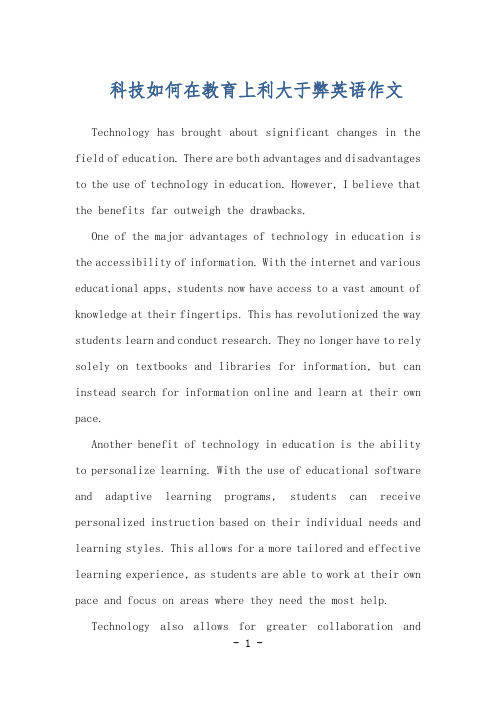
科技如何在教育上利大于弊英语作文Technology has brought about significant changes in the field of education. There are both advantages and disadvantages to the use of technology in education. However, I believe that the benefits far outweigh the drawbacks.One of the major advantages of technology in education is the accessibility of information. With the internet and various educational apps, students now have access to a vast amount of knowledge at their fingertips. This has revolutionized the way students learn and conduct research. They no longer have to rely solely on textbooks and libraries for information, but can instead search for information online and learn at their own pace.Another benefit of technology in education is the ability to personalize learning. With the use of educational software and adaptive learning programs, students can receive personalized instruction based on their individual needs and learning styles. This allows for a more tailored and effective learning experience, as students are able to work at their own pace and focus on areas where they need the most help.Technology also allows for greater collaboration andcommunication among students and teachers. With online platforms and tools such as video conferencing and collaborative documents, students can easily work together on projects, share ideas, and communicate with their teachers outside of the classroom. This fosters a more collaborative and interactive learning environment, which can lead to increased engagement and motivation among students.Furthermore, technology in education has also made learning more interactive and engaging. With the use of educational games, simulations, and multimedia resources, students can learn through hands-on experiences and visual aids. This not only makes learning more enjoyable, but also helps students retain information better and develop critical thinking and problem-solving skills.Despite these advantages, there are some drawbacks to the use of technology in education. One of the main concerns is the potential for increased screen time and its impact on students' physical and mental health. Excessive use of technology can lead to issues such as eye strain, poor posture, and decreased physical activity. Additionally, it can also contribute to mental health issues such as anxiety and depression.Another drawback is the potential for technology to be adistraction in the classroom. With the prevalence of smartphones and other devices, students may be tempted to use them for non-educational purposes during class time. This can lead to decreased focus and attention, as well as a lack of engagement in the learning process.Despite these drawbacks, I still believe that the benefits of technology in education outweigh the drawbacks. By implementing proper guidelines and regulations, educators can minimize the negative effects of technology and maximize its potential for enhancing the learning experience. Overall, technology has the power to transform education and provide students with the tools and resources they need to succeed in the 21st century.科技在教育上的利大于弊。
信息技术对教育产生的正负面影响英语作文
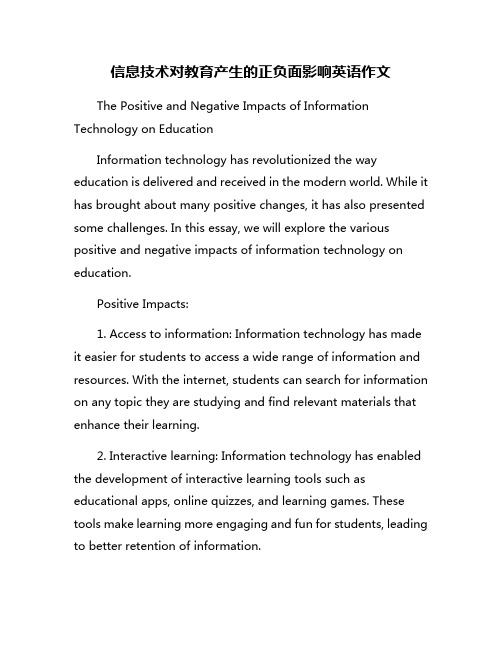
信息技术对教育产生的正负面影响英语作文The Positive and Negative Impacts of Information Technology on EducationInformation technology has revolutionized the way education is delivered and received in the modern world. While it has brought about many positive changes, it has also presented some challenges. In this essay, we will explore the various positive and negative impacts of information technology on education.Positive Impacts:1. Access to information: Information technology has made it easier for students to access a wide range of information and resources. With the internet, students can search for information on any topic they are studying and find relevant materials that enhance their learning.2. Interactive learning: Information technology has enabled the development of interactive learning tools such as educational apps, online quizzes, and learning games. These tools make learning more engaging and fun for students, leading to better retention of information.3. Globalization of education: Information technology has facilitated the globalization of education by allowing students to connect with peers and experts from around the world. This has opened up new opportunities for collaboration and learning from diverse perspectives.4. Personalized learning: Information technology has made it possible to tailor educational content to the individual needs and learning styles of students. Through adaptive learning platforms, students can receive personalized feedback and recommendations to help them improve their understanding of the material.Negative Impacts:1. Distraction: The use of information technology in education can be a source of distraction for students. With constant access to social media and other entertainment platforms, students may find it difficult to stay focused on their studies.2. Dependence on technology: As education becomes increasingly dependent on information technology, students may become reliant on digital tools for learning, to the detriment of their critical thinking and problem-solving skills.3. Inequality: Access to information technology is not equally distributed among students, leading to a digital divide. Students from disadvantaged backgrounds may not have access to the same technology as their more privileged peers, creating disparities in educational opportunities.4. Privacy concerns: The use of information technology in education raises concerns about privacy and data security. Schools and educational institutions may collect and store sensitive information about students, leading to potential breaches of privacy.In conclusion, information technology has both positive and negative impacts on education. While it has expanded access to information and enhanced interactive learning, it has also brought about challenges such as distraction, inequality, and privacy concerns. It is important for educators and policymakers to carefully consider these impacts and strive to mitigate the negative effects while maximizing the benefits of information technology in education.。
- 1、下载文档前请自行甄别文档内容的完整性,平台不提供额外的编辑、内容补充、找答案等附加服务。
- 2、"仅部分预览"的文档,不可在线预览部分如存在完整性等问题,可反馈申请退款(可完整预览的文档不适用该条件!)。
- 3、如文档侵犯您的权益,请联系客服反馈,我们会尽快为您处理(人工客服工作时间:9:00-18:30)。
Module EF5231 Academic Writing for non-native Speakers of EnglishAssessment 002JIACHENG-CAO (Rex)S131416712 December 2014Essay OutlineEssay Title:The use of technology in education has increased in recent years. Discuss the advantages and disadvantages of using technology in education, with regard to both teachers and students. Give examples from your own experience of studying to support your argument.Technology in classroom is not new. Indeed, technology has been around in education for decades-one and might be argued for centuries, if we classify the blackboard as a form of technology. "Tape recorders, language laboratories Tape recorders, language laboratories and video have been in use since the 1960s and 1970s, and are still used in classrooms around the world. Computer-based materials for language teaching, often referred to as Call (computer Assisted Language Learning), appeared in the early 1980. ”(Dudeney, 2007, p8)Technology is a tool in the classroom which tries to constantly improve the quality of teaching and the efficiency to allow people to become easier and more convenient in learning through science and technology tools. Technology products have been gradually integrated into our life, and even have become an integral part of our lives. There are many technology products used in education. It has become a hotly-debated issue, whether the educator should greatly accept the development of technology. Advocates of using technology in education argue that the science and technology can effectively improve studying, such as network education system, computer and multimedia tools. They are the leading cause of improving education diversity. However, other people believe that school should follow the traditional education. There are many uncertainties in technology products. Students may be faced with many temptations and adverse influences from technology products. Technology in the classroom needs to spend a lot of money. They claimed that it is wasteful, unwise and unacceptable. This essay intends to explain the pros and cons with use the technology in education.First of all, the computer is the most representative of technology products used in education. It can offer a range of services and convenience for students to study, such as e-learning, reading online and researching information. With the help of these resources, the students' learning will be improved greatly. Clark (2008, P 37) claims that “reading online content is similar to reading printed material, but online material is designedvery differently from a book.” Student will no longer worry about taking a number of books to school. Aside from convenience, distance education programs can be economical and environmentally friendly. It is not necessary to connect with the internet; It will be easy to find a book which read. Maybe in the near future e-books will replace paper books.Furthermore, Tele-education has been increasingly popular on the internet. Wireless Fidelity is now widely available on trains and in hotels, cafes, libraries and a variety of other public spaces. (Clark .2008) Students can use lap-top, Ipad or mobile phone to study anywhere by connecting to the Internet. Technology provides the possibility of learning while on a bus or outside. It is not necessary to own the technology produce; the Cybercafés has already offered the service. It is only necessary to pay a little money then to use their computers. Even if far away from home or college, the students also can carry on with their studies. (Clark, 2008) Technology products are available to the learning spaces. In the students' learning sites are not limited at school or at home. The way and place of studying is also becoming flexible.On the other hand, technology products also bring some threat to studen ts ’study. Although technology products can bring convenience to study, it may also influence them in undesirable ways. People like to use e-learning because they can save every-thing. There is no need to read the material or make any particular effort to understand the content. It may lead to impairing the ability of students to analyst information and it may be easy to make mistakes in their studying. (Clark,2008) Students will grow dependent on learning tools to study and it may reduce their autonomous learning. Over relying on electronic products may take a heavy toll on student’s study.Moreover, contacting with electronic products and network for a long time may easily suffer from a series of threat, such as, Internet addiction, Internet pornography and cyber-violence. Admittedly, exposure to violent movies may lead to aggressive and antisocial behaviors. An avid pursuit of science and technology products probably may lead to internet crime. Many parents said that children’s’ prolonged time working on the computer easily lead to testiness, decadence and selfishness. A growing volume of experience suggests that under the impact of negative net-culture, youths willpower isweakened, which results in the increase of juvenile delinquency, personality defects, and damages to their physical, emotional and mental well-being.Technology not only plays an important role in students’ study but also influences the teachers’ job. Students studying in school may find that technological devices are increasing gradually. Undoubtedly, the technology devices have become an indispensable part of educational tool in the classroom.Firstly, technology products probably offer a lot of information for teachers to prepare for their teaching.Dudendy claimed that (2007, p8) technology is offered with published materials such as radio, photo or resource books for teachers. For example, in the Internet an educator could find numerous materials and create a power-point courseware. Class education will not be trapped in text reading, because technology can provide the condition which would makes the course more enriching, interesting and easier to grab the attention of the students. According to experience, technology products have a great probability of improving the quality of teaching and promoting education.Furthermore, technology may help teachers to increase their efficiency and reduce workload in the school education. Davies stated that (2010, p8) “if designed appropriately, computer-assisted assessment offers a number of benefits that can enhance learning and reduce the workload of administrators.” For example, assessments online, it can access a greater range of locations for paper examinations. Teachers could transport students’ work from home and access grades from multiple locations. Teachers may also teach in a tele-teaching format, which allows them to potentially take on more students and course sections because meeting times are more flexible or non-existent. Experience suggested that online assessment is feasible. Students could submit their assessment to the campus network system, and then the teacher could check the homework and return marks, all online.While technology use in education could bring a range of benefits, however, it also has some limitations. Technology is essential for teachers but there are some instanceswherein this technology is seen to be disadvantageous for both teacher and student having as well.A number of students and teachers lack technology knowledge. They do not know what it is or how to use it. Dudeney stated that (2007, p9) teachers having negative attitudes to technology is usually the cause of a lack of facilities, a lack of confidence or a lack of training. If a teacher is not comfortable teaching with technology, this can be worse than teaching without it. It leads to an inability to see the advantage of using technologies in the classroom. People cannot imagine that in the class room over half of the time the teacher struggles how to use the computer.Moreover,according to experience, lack of support is one of leading causes of limited use of technology in education. Technology can provide much frustration to the students and teachers if the instructors cannot support the hardware in the classroom. If schools cannot support their purchased technology, then the equipment goes unused and may waste money. Even if, school decided to purchase some computers, they cannot guarantee to provide enough computers for every student to use. Many students claim that (Dudeney, 2007, p9) “A teacher may want to use more te chnology in their teaching, but the school may not have the facilities.” Last, with technology constantly being renewed, maintenance of these devices may become a serious problem.In conclusion, this essay has discussed the effects of technology used in education, and has shown that it may be both negative and positive. Although in some situations technology products used in the education still have many problems, technology is still the hope in the future for development of education. The use of technology in the classroom is a good way to enhance educational innovation and diversification. Consequently, it can be suggested that governments should take steps to fund technology used in education and strengthen network supervision to reduce the spread of unhealthy information, and provide technical guidance in order to improve teachers and students IT skills. Technology use in education has become a development trending most of people still believed it may bring more contribution to education.Reference:Clark, C. (2008) ‘Traditional skills’, Palgrave study skills: e-learning skills. 2nd edn. Hampshire: Palgrave Macmillan, p. 32Clark, C. (2008) ‘Learning environments’, Palgrave study skills: e-learning skills. 2nd edn. Hampshire: Palgrave Macmillan, p. 111Clark, C. (2008) ‘Traditional skills', Palgrave study skills: e-learning skills. 2nd edn. Hampshire: Palgrave Macmillan, pp. 36 - 37Dudeney, G. & Hockly, N. (2007) Teach English with Technology, Harlow: Pearson LongmanOnline Effective Assessment in a Digital Age, A guide to technology-enhanced assessment and feedback/media/documents/programmes/elearning/digiassass_ead a.pdf(2010)(Accessed: 1 December 2014)。
